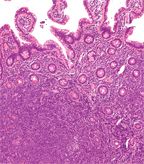Ibrutinib Shows High Response Rate in Mantle-Cell Lymphoma
Phase II trial results of the targeted agent ibrutinib in relapsed or refractory mantle-cell lymphoma show that the drug led to promising and durable responses.
The targeted agent ibrutinib has shown promising and durable responses in patients with relapsed or refractory mantle-cell lymphoma (MCL). The results of a large phase II trial are published in the New England Journal of Medicine. Interim results were originally presented at the annual meeting of the American Society of Hematology (ASH) in December 2012.

Intermediate magnification micrograph of mantle-cell lymphoma of the terminal ileum; Copyright © 2010
Nephron
Sixty-eight percent of patients (75 of 111) responded to monotherapy with ibrutinib. Patients experienced both complete responses (21%) and partial responses (47%). Responses were seen in patients regardless of whether they had previously been treated with the proteasome inhibitor bortezomib.
“Previously, such a high rate of complete response in this population with substantial previous treatment has been achieved only with intensive chemotherapy regimens, all of which are myelotoxic,” stated the authors.
The estimated median duration of response is 17.5 months, with an estimated median follow-up of 15.3 months. The estimated median progression-free survival is 13.9 months. Most patients responded to therapy within 2 months.
At 18 months, the estimated median overall survival rate is 58%. The median overall survival has not yet been reached.
Patients on the trial had intermediate- or high-risk MCL and a median of three prior therapies. More than three-quarters of the patients had stage IV disease.
Ibrutinib was given as a 560-mg daily dose until disease progression or until the drug’s side effects became intolerable.
Most toxicity events were low-grade, including diarrhea (50% of patients), fatigue (41%), nausea (31%), peripheral edema (28%), dyspnea (27%), constipation (25%), upper respiratory tract infection (23%), vomiting (23%), and decreased appetite (21%). High-grade pneumonia occurred in 6% of patients. High-grade hematological malignancies included thrombocytopenia (11%) and anemia (10%). Four patients suffered from subdural hematomas, but all four patients had factors that put them at risk for such an event, including anticoagulant and antiplatelet therapies.
According to the study authors, more trials are needed to understand whether bleeding is increased during ibrutinib therapy.
MCL is an aggressive type of non-Hodgkin lymphoma. While rare (approximately 6% of non-Hodgkin lymphomas are MCL), the disease typically has a poor prognosis. Patients often respond to toxic chemotherapy and immunotherapy drug combinations followed by stem cell transplants, but responses tend not to be durable.
“This drug, which is the safest option we have for MCL, shows unprecedented durable single-agent activity,” said lead study author Michael Wang, MD, associate professor in the departments of lymphoma/myeloma and stem cell transplantation and cellular therapy at the University of Texas MD Anderson Cancer Center in Houston, in a statement. “The favorable toxicity profile also implies that ibrutinib provides the opportunity for less intense and more effective regimens. The long-term impact of ibrutinib definitely warrants further clinical testing.”
Ibrutinib is an oral inhibitor of Bruton's tyrosine kinase (BTK), a crucial signaling molecule in the B-cell receptor pathway. The drug has been shown to cause cell death and to lower the rate of movement of cancerous B cells. In February, the drug was granted Breakthrough Therapy Designations as a monotherapy for MCL and for Waldenstrm's macroglobulinemia by the US Food and Drug Administration (FDA).
The drug is also being studied for treatment of chronic lymphocytic leukemia and small lymphocytic lymphoma, and was granted Breakthrough Therapy Designation for these indications by the FDA in April.
Highlighting Insights From the Marginal Zone Lymphoma Workshop
Clinicians outline the significance of the MZL Workshop, where a gathering of international experts in the field discussed updates in the disease state.